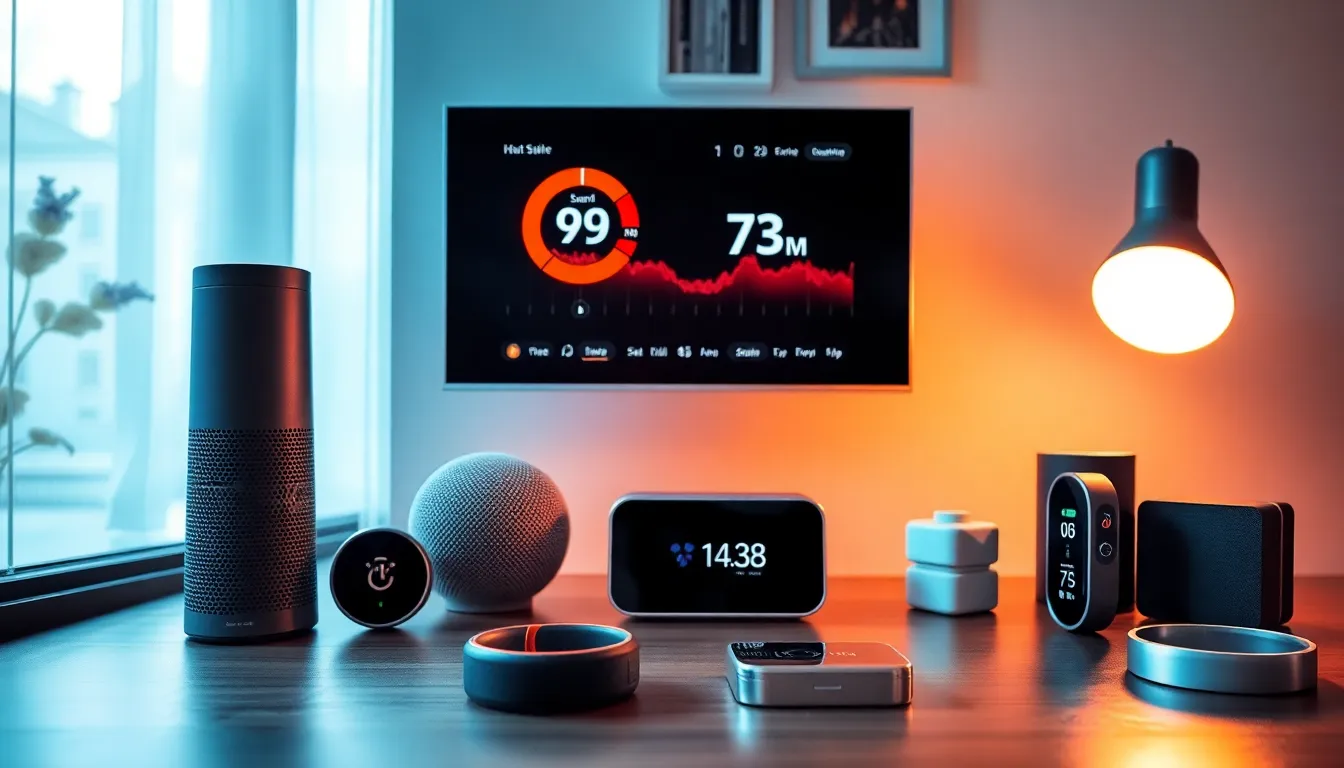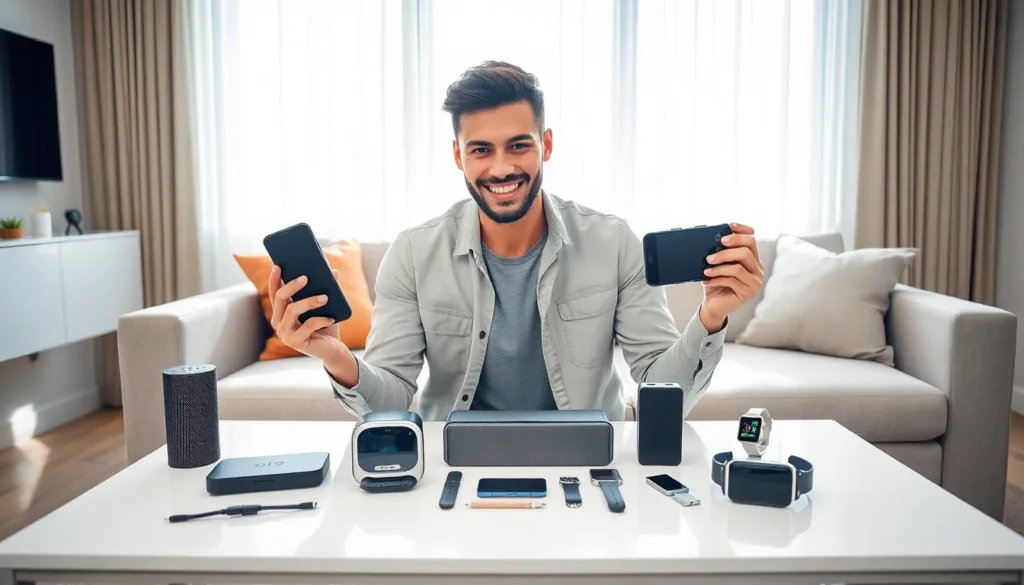Table of Contents
ToggleIn a world where gadgets evolve faster than a toddler can throw a tantrum, staying ahead of the curve can feel like a race against time. From smart home devices that practically run your life to wearables tracking every heartbeat, the latest trends are nothing short of exhilarating. If you think your phone’s just a phone, think again—it’s basically a Swiss Army knife in your pocket, ready to tackle anything from grocery lists to virtual meetings.
Overview of Gadget Trends
Gadget trends are constantly shifting, driven by technological advancements and consumer preferences. Emerging smart home devices, including smart speakers and connected appliances, enhance convenience and energy efficiency. High demand for wearable technology persists, with fitness trackers and smartwatches providing users with health-monitoring capabilities.
Mobile devices continue to evolve, integrating advanced features like AI-driven applications and enhanced camera systems. Innovative laptops offer unique form factors, such as 2-in-1 functionality, appealing to professionals and students alike. Virtual reality and augmented reality gadgets expand entertainment possibilities and training applications, immersing users in interactive environments.
Sustainability is becoming a priority in the tech industry, with companies developing eco-friendly gadgets made from recyclable materials. Increased focus on cybersecurity leads to the creation of gadgets equipped with advanced privacy features, ensuring user data protection. Streaming devices also gain traction, allowing users to access vast libraries of content effortlessly.
Collaboration tools become essential in remote work environments, pushing brands to develop gadgets that facilitate communication and productivity. Robotics technology finds applications in various sectors, from home assistance to agriculture. Overall, the landscape of gadgets is dynamic, reflecting current tech innovations and consumer desires.
Emerging Technologies

Emerging technologies continue to drive gadget trends, creating novel experiences and enhancing functionality. The following areas play a significant role in this evolution.
Artificial Intelligence in Gadgets
Artificial Intelligence (AI) increasingly shapes gadget design and functionality. AI enhances user experiences through personalization, predictive capabilities, and automation. Smart speakers utilize AI for natural language processing, allowing users to control devices hands-free. Fitness trackers incorporate AI to analyze health data and provide tailored recommendations. Voice assistants become more intuitive, adapting to user preferences over time. These advancements lead to gadgets that understand and meet individual needs more effectively.
Internet of Things Integration
Internet of Things (IoT) integration transforms how devices communicate and function together. Smart home ecosystems capitalize on IoT to connect devices seamlessly, improving convenience and energy efficiency. Appliances now interact, enabling users to control settings remotely through mobile apps. Smart thermostats learn user routines to optimize energy consumption, reducing costs significantly. Wearables also benefit from IoT, enabling real-time data sharing between devices for enhanced health monitoring. The synergy between IoT and gadgets continues to shape user experiences and lifestyle enhancements.
Popular Gadget Categories
Gadget categories reflect innovation and consumer interest. This section explores the key areas driving current trends.
Wearable Technology
Wearable technology encompasses devices that integrate seamlessly into daily life. Smartwatches, such as the Apple Watch and Samsung Galaxy Watch, offer fitness tracking, heart rate monitoring, and notification capabilities. Fitness trackers, including Fitbit and Garmin products, provide insights into physical activity, sleep quality, and overall health metrics. These gadgets boost wellness awareness, making healthy choices more accessible. Customization options enhance user engagement, allowing users to personalize settings and features. With the rise in health consciousness, demand for wearables continues to grow, making them a staple in modern lifestyles.
Smart Home Devices
Smart home devices transform living spaces into connected environments. Popular examples include smart speakers, like Amazon Echo and Google Nest, which offer voice control for various tasks. Connected appliances, such as smart refrigerators and thermostats, enhance convenience by allowing remote management through mobile apps. Energy efficiency is a key advantage, as these gadgets optimize resource use and reduce utility bills. Security devices, including smart cameras and doorbell systems, provide real-time monitoring and alerts, increasing home safety. As integration with IoT technology expands, smart home devices will play an essential role in enhancing everyday life.
Mobile Gadgets
Mobile gadgets continue to evolve, enhancing communication and productivity. Smartphones have advanced significantly, featuring high-quality cameras, AI capabilities, and extensive app ecosystems. Tablets, such as the iPad and Microsoft Surface, offer versatile options for entertainment and work on the go. Laptops with 2-in-1 functionality cater to both professionals and students, combining portability with performance. Innovations in mobile technology include enhanced battery life, 5G connectivity, and improved display quality, catering to users’ diverse needs. As productivity demands increase, mobile gadgets remain vital tools for staying connected and efficient.
Influential Brands in the Market
Several brands significantly shape the gadget landscape, influencing consumer choices and trends in technology.
Established Companies
Apple, Samsung, and Microsoft reign as dominant forces in the gadget market. Apple’s iPhone and iPad consistently set standards for smartphones and tablets, showcasing advanced technology and user-centric design. Samsung’s Galaxy series offers a variety of devices that cater to various consumer preferences, ensuring broad market appeal. Microsoft remains a leader in the computing sector with its Surface devices, combining productivity and portability. Each company emphasizes innovation, ensuring continuous advancements in functionality and features, reinforcing their positions in an ever-evolving tech environment.
Startups to Watch
Several startups show promising potential in the gadget market, driven by innovation and fresh ideas. Nothing, a company focused on creating transparent designs, offers unique smartphones and earbuds that challenge conventional aesthetics. Anker, known for portable charging solutions, expands into smart home devices, emphasizing convenience and integration. Oura, specializing in health technology, produces a smart ring that monitors sleep and activity comprehensively. These startups, alongside established brands, contribute to a dynamic landscape, showcasing creativity and forward-thinking ideas that cater to modern consumers’ needs.
Consumer Preferences
Consumer preferences in the gadget market reflect a growing desire for innovation, functionality, and sustainability. Many buyers seek devices that offer cutting-edge technology along with practical applications in their daily lives. Smart home devices, such as smart speakers and connected appliances, lead the way, providing convenience and energy savings.
Wearable technology remains popular, with fitness trackers and smartwatches gaining traction among health-conscious individuals. Such gadgets offer personalized health insights, motivating users to achieve wellness goals. Mobile devices continue to evolve, featuring AI-driven applications and advanced camera systems that enhance user experience.
Sustainability is a crucial factor influencing consumer choices. Eco-friendly gadgets crafted from recyclable materials attract environmentally-conscious buyers, showcasing the industry’s commitment to reducing its carbon footprint. Additionally, security features on gadgets appeal to privacy-aware consumers, making safety a key consideration.
Streaming devices have surged in popularity, allowing easy access to audiovisual content. The demand for laptops that support remote work also rises as professionals require tools to enhance productivity and collaboration. Connected gadgets now play an essential role in creating efficient communication environments.
The presence of influential brands shapes consumer preferences. Established players, like Apple and Samsung, maintain high standards in design and functionality, while innovative startups such as Anker and Oura introduce unique products that capture consumer interest. These dynamics reflect the diverse needs of tech-savvy individuals seeking modern solutions tailored to their lifestyles.
The gadget landscape is evolving at a remarkable pace. With advancements in AI and IoT, devices are becoming smarter and more interconnected. As consumers prioritize functionality and sustainability, tech companies are responding with innovative solutions that enhance daily life.
The trend toward eco-friendly gadgets reflects a growing awareness of environmental impact. Privacy and security also remain top concerns, prompting manufacturers to integrate advanced features into their products.
As new technologies emerge, the excitement surrounding gadgets will only intensify, shaping how people interact with their devices and each other. The future looks bright for tech enthusiasts and casual users alike.










